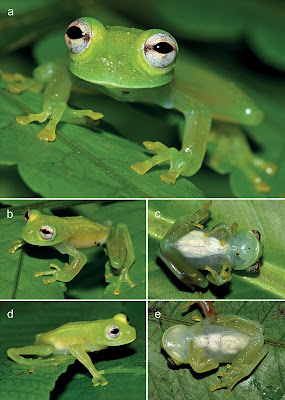 |
| Chimerella mira Köhler, Venegas, Castillo-Urbina, Glaw, Aguilar-Puntriano & Vences, 2023 Comparison of eye colouration in life: *b male Chimerella mira sp. nov. *d female Chimerella corleone |
Abstract
We studied the taxonomic status of glassfrogs collected in Departamento Huánuco, central Peru, which in the field were tentatively allocated to Chimerella, one of the twelve genera currently recognized in the family Centrolenidae. Detailed analyses of their morphology, bioacoustics, and molecular genetics supported their generic allocation and provided evidence for them representing a divergent and unnamed evolutionary lineage within Chimerella. We herein describe this lineage as a new species, being mainly distinguished from the two other known congeners, C. corleone and C. mariaelenae, by details of colouration in life and preservative, substantial differences in advertisement call, and differentiation in mitochondrial markers (12S rRNA, 16S rRNA, cytochrome b) and a nuclear-encoded marker (Rag-1). The new species is the southernmost distributed species in the genus and was found in a swampy habitat at the bank of the Río Patay Rondos, a tributary of the Río Monzon, in rainforest at the Andean-Amazon foothills at 798 m above sea level. Aspects of species delimitation within Chimerella and related future research are briefly addressed and discussed.
Key Words: Amphibia, Chimerella mira, new species, bioacoustics, molecular genetics, morphology
Chimerella mira sp. nov.
Diagnosis: The new species is morphologically most similar to C. corleone. However, it differs from C. corleone by fine dark spots in the iris in life (versus dark reticulation; Figs 4, 5), a truncate snout in lateral profile (versus slightly rounded; Fig. 6), tarsal fold absent (versus present as a line of low white warts on the lateral edge of tarsus), greyish-lavender dorsal colour in preservative (versus greyish-green), a dispersed network of melanophores on dorsal surfaces resulting in a light yellow-green colour in life (versus a very dense network of melanophores on dorsal surfaces, resulting in dark green life colouration; Figs 3, 4), a call consisting of pulsed ‘Trii’ notes (sensu Duarte-Marín et al. 2022) with 42–85 ms duration (versus simple ‘Tic’ notes of 10–15 ms duration), and substantial differentiation in certain molecular markers. The new species mainly differs from C. mariaelenae by a yellow-green dorsum with small round scattered yellowish flecks (versus green dorsum with black flecks and punctuation; Fig. 7), greyish-lavender dorsum with small round cream flecks in preservative (versus pale lavender with dark lavender flecks), silvery white iris in life (versus orange to reddish iris), an advertisement call consisting of pulsed ‘Trii’ notes with 42–85 ms duration (versus simple ‘Tic’ notes of 4–7 ms duration; Guayasamin et al. 2020), and substantial differentiation in certain molecular markers.
Etymology: The specific epithet is a Latin adjective (feminine form) meaning ‘surprising’. It refers to the fact that this species surprisingly turned out to be undescribed, after at first impression in the field having been tentatively identified as C. corleone.
Jörn Köhler, Pablo J. Venegas, Ernesto Castillo-Urbina, Frank Glaw, César Aguilar-Puntriano and Miguel Vences. 2023. A Third Species of Glassfrog in the Genus Chimerella (Anura, Centrolenidae) from central Peru, discovered by An Integrative Taxonomic Approach. Evolutionary Systematics. 7(2): 195-209. DOI: 10.3897/evolsyst.7.102950





